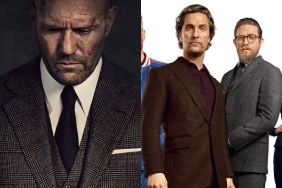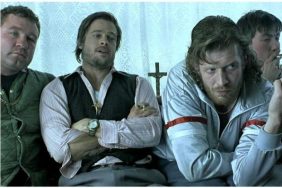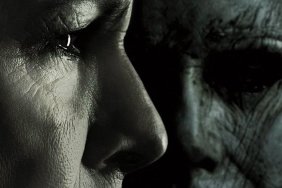Are you man enough? I mean, really. Are you? Because Jason Statham certainly is. He’s man enough in a way that only certain sentient beings with enough testosterone and opposable thumbs can be. Here at The Myth of Macho, we know about what makes you manly, and… well, we have decided that Jason Statham most certainly counts.
Back in the day, the tough wiry energy of Lee Marvin was widely considered to be one of the best examples of masculinity and male-“ness.” During the 80s and 90s, films like Tango and Cash documented stars like Sylvester Stallone and Kurt Russell in their sleek machismo, topped only by films like Backdraft that showcased a variety of action/macho figures from old school-types (Robert DeNiro) to the same standbys (Kurt Russell again). Today, it is rare to see a film like Warrior, where the men truly look like men, battle-scarred, mature and robust. Young in age, but not in experience. In all honesty, the kind of action stars that films seem to be offering these days bear more similarity to college students or fashion models. While they may be increasingly easy on the eyes, the suspension of disbelief gets a much greater workout when trying to think about a fashion model trying to kick as much ass as a man whose body bears the marks of his life’s travels. Not much plausibility there.
Don’t get me wrong: I really like Christian Bale and Matt Damon as actors. Hell, I may even be the one person who liked the Jason Momoa version of Conan the Barbarian (Marcus Nispel, 2011). But there is something about choosing men who look like they were pulled from the latest “Obsession for Men” photo campaigns to be the Triumphant Men of Action in the cinema that drives me a little batty. Chris Hemsworth? While he certainly resembles the part of a Norse deity, he looks like they snagged him from Asgard while he was still in god-college. He may be hot, but as Thor, his power seems to come more from his mirror-shatteringly beautiful face than any “I’ve Been Through Hell, Don’t Cross Me” experience.

I’m not questioning the masculinity of the men who qualify under the New Action Hero, but it is abundantly clear that there has been a quantifiable shift from yesterday’s action stars to today’s by way of aesthetic. In essence, lying underneath the action and heroic deeds in our cinema seems to be the message that you must be really pretty too, a very different and confusing message considering what it was back in the day. If we really stop to think about it, men like those depicted in The Wild Bunch (Sam Peckinpah, 1969) may not have been raging sexpots but would you have wanted to mess with them? Not a chance!
So back to Statham. As my parents like to ask around certain Jewish holidays, what makes this muscle-bound action star different from all other muscle-bound action stars? (Okay, okay, so maybe that’s not exactly what they ask but close enough.) Jason Statham is most certainly one of the most popular men in his field. But Statham is of consequence because of something aside from his popularity: he resembles a real man. While this may not seem like a big deal to most people, in the nouveau Robert Pattinson-universe, it kinda is.

What does a “real man” look like? Well, there are a thousand variations, of course, and there is no one right answer. But in comparison to the dazzlingly gorgeous fresh-faced baby boys that are parading across our screens more and more, Jason Statham looks more and more like the rugged “hero” and “man’s man.” While Statham actually was a model before he was an actor, he’s also only 5’9” (his Victoria’s Secret model girlfriend is taller than him in heels), shaves his head possibly due to a receding hairline, and his career has only really exploded within the last 10 years. Jason Statham is 45 years old. The definition of “no spring chicken.” However, he also comes up on every list of “hottest/favorite/best male action stars” and seems to be getting more attention as he gets deeper into the profession. Clearly there is still a desire within audiences for something other than pretty boys to save the world. If our focus in action casting is fluctuating more towards the aesthetic and less towards the ability, Statham’s staying power is certainly something to take note of. Why keep him around if everyone is just getting prettier? That’s not his skill.
Rabid action fans and general audience members have not been the only ones to notice it either. Jason Statham’s more craggy appearance combined with his high-octane physical performances has made him the ideal figure for a hybrid of action films being released within the last few years. This collection of films puts Statham at the center and has managed to create a persona for him that is a consistently intoxicating blend of tough asskicker, strong silent type, and ethical anti-hero without the unnecessary superficial “gear” of looking like Chris Pine. It’s not that Jason Statham is ugly. He most certainly is not. But Robert Ryan wasn’t ugly. Neither was Clint Eastwood. And for heaven’s sake, anyone who thinks Steve McQueen was ugly needs to get his or her eyes checked. The issue at stake is that, when you see these guys dishing it out on the silver screen, they appear to be grown men doing it, not glorified teenagers with muscles. Statham happens to share this characteristic and due to that he now inhabits the position of New Old School Action Hero.

After seeing Statham in Crank (Mark Neveldine, Brian Taylor, 2006) comedian and actor Patton Oswalt proclaimed, in no uncertain terms, that he was “gay-tham for Statham.” In doing so, he more or less invented the maxim that is used on a fairly frequent basis by people who could not see their film collections being the same without all three of the Transporter films. The problem with this proclamation, however, is that it was done after watching Crank, the most mind-blowing and outrageous of all of the films Jason Statham has done thus far in his career. Frankly, there are large sections of the film that will have your mouth wide open in disbelief. This film is not your average action film. Yet, Oswalt is 100% accurate in declaring that it is his best. The surrealism and complete bizarreness that is part and parcel of Crank is something that I have rarely experienced in any other film work, and most certainly not in the rest of the Statham oeuvre. The rest of his films are very upfront and straight forward (although some argue that certain films feature a homoerotic subtext) as far as narratives go and play out like straight-up action films, thus reifying everything about him as the standard by which other action heroes and films can be held.
But what of this strange anomalous film, stuck in the middle of everything else? And does that mean that perhaps there are other ways to examine the seemingly “average” and “straight ahead” works that Statham does? The basics on Crank is that it’s about a guy who has been poisoned and has to keep his heart rate up so that he doesn’t die from the poison he has been injected with. To be honest, Crank is really just a modernized and off-the-wall variation on Rudolph Maté’s film noir, D.O.A. In my eyes, Crank is what you would get if you had John Waters remake D.O.A. and cast Jason Statham in the Edmond O’Brien role. And it’s addictive as all get out. After watching it, I wanted to watch it all day every day. So either this film contains numerous subliminal messages that Patton Oswalt, myself, and other fans of the film picked up on or… it’s just an insanely enjoyable psychotic film. I’m willing to accept either, really.

But the experience of watching Jason Statham pounce around Los Angeles trying to keep his heart rate up at ridiculous costs in Crank is not experiencing him in his other work. Where Crank is in your face to the point of being ridiculous, his other action films follow a greater sense of action normalcy. Crank’s sensibility isn’t Standard Statham Cinema. Not by a long shot. Watching him beat men to a bloody pulp or protect women and children in Transporter 1 (Louis Leterrier, Corey Yuen, 2002) and Transporter 2 (Louis Leterrier, 2005) is an entirely different situation. His role as Frank Martin, the “transporter” of packages who breaks the rules and must manage the consequences in Transporter 1 and is implicated in a kidnapping that he did not commit and must fight his way out in Transporter 2 is straight up traditional action cinema. If Old School action hero Steve McQueen’s character Frank Bullitt had been around to see the car chases in the Transporter films, he’d’ve been seething with jealousy. But that’s not the only way that this series – and its star – align themselves with Old School action cinema tropes: the Transporter films have enough fistfights, physical confrontation and gun battles that the spoken dialogue from Statham is quite minimal, thus bringing him much closer in character to many of Eastwood’s action heroes: silent but deadly.
While the Transporter films are only one example in many, they represent the persona that people know and love when they think “Statham Film.” Jason Statham’s presence in the action film genre is invaluable due to the recent history of action films themselves. Action cinema has always formed itself around minor cults of personality. Are you a Seagal fan? A Stallone person? Do you go in for Lundgren or are you more on the Van Damme tip? And it wasn’t so different back in the classic cinema days either. Who was tougher: Van Cleef or Eastwood? Who would win in a fight: Jack Palance or Burt Lancaster? Were you for Alan Ladd or Humphrey Bogart? Statham is “Third Wave” Action Star, having carved out a unique path for himself and established himself as a brand and a personality, much as all his predecessors did.

But Statham adds something different to the mix. While some things about his career path may seem formulaic and his identity may seem to be as cookie cutter as any other past blockbuster action star, Jason Statham has one major thing that sets him apart: to my knowledge, he is the first major action star who has appeared in a series of action films that not only feature gay characters but make a concerted effort not to demonize them. It’s not that Jason Statham is gay. He’s not. But as a modern action star, he is clearly at ease with his masculinity. In any case, he is certainly comfortable enough to appear in not one, not two but three different films where male homosexuality is part of the script. *
Things get truly fascinating when you start looking at films like Death Race (Paul W.S. Anderson, 2008), the remake of The Mechanic (Simon West, 2011), and Blitz (Elliot Lester, 2011). Each one of these films contains gay characters that various critics and gay publications did not feel were damaging to the LGBT community. Indeed, critic Alonso Duralde stated in his review that “seeing a gay assassin in The Mechanic – a film in which most of the major characters are killers themselves – feels like another step forward on the road to equality.” Seeing as the vast majority of action movies of the past have managed to treat homosexuality as either entirely unacceptable or aligned it with the contingent of villains needing to be eradicated, the presence of gay characters within the text of action films is a pretty big deal. Considering Statham’s power as an action icon, his association with these films does have a meaning. By being an active and crucial part of them he is, in a sense, providing much-needed support and backing.

The likelihood that Statham (or his agent) looked at the scripts for these films and geared his decision even partially based upon the “gay” factor is highly unlikely if not impossible. What is possible, however, is that Jason Statham’s participation in an expanded action world presents a set of masculine values that allows for gay characters to exist on equal footing with everyone else in this genre space. The identity of Jason Statham was built to be just as much a knock-out presence on the scene as Sylvester Stallone or Arnold Schwarzenegger, but instead of reflecting a masculinity that was fixed and unchangeable, the Jason Statham Action Hero is updated, modern and, if nothing else, complex and ready to approach these issues in a way that the previous generations of action men were not.
While the presence of homosexuality in the Cinema of Statham is a new angle for action cinema, it is not what sells his work. It is simply what updates it and brings it into a new age where things are not so closed. However, his own silent and stern sexual magnetism in tandem with his physical ability to level a playing field full of other equally gifted hitmen/criminals/etc. is not something that can be denied. What Statham has is the same element of masculinity that has driven women to the theaters to drool and men to the box office to worship for the last almost 100 years: male authority. Whether he is an Expendable or a boxing promoter in a film like Snatch (Guy Ritchie, 2000) his authoritative body language, dominant persona, and animalistic sensuality drive him to the top of the action list, with no signs of his coming down any time soon
Thanks again for joining us in this week’s discussion of the The Myth of Macho. Remember: the brain is a muscle… pump it up!
*There is much discussion about Transporter 2 having a gay subtext, but I’m not including that in this discussion because it was not explicitly stated until afterwards by the director. Even then… he seemed a bit jokey and wishy-washy about it. I’m not certain how much I buy Frank Martin’s homosexuality, with or without the super-hot love scene between him and Natalya Rudakova in Transporter 3 (Olivier Megaton, 2008).
Ariel Schudson is a featured columnist at CraveOnline and the president of the Student Chapter of the Association of Moving Image Archivists at UCLA. Stalk her electronically at @Sinaphile








